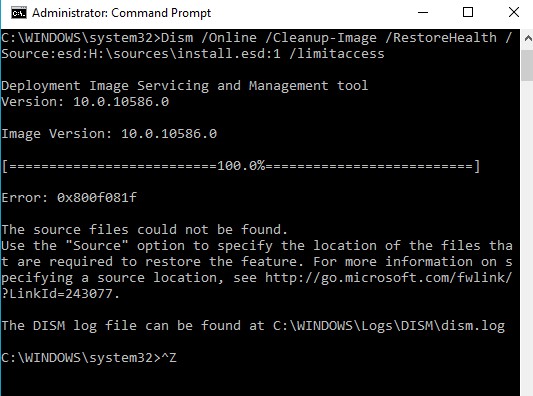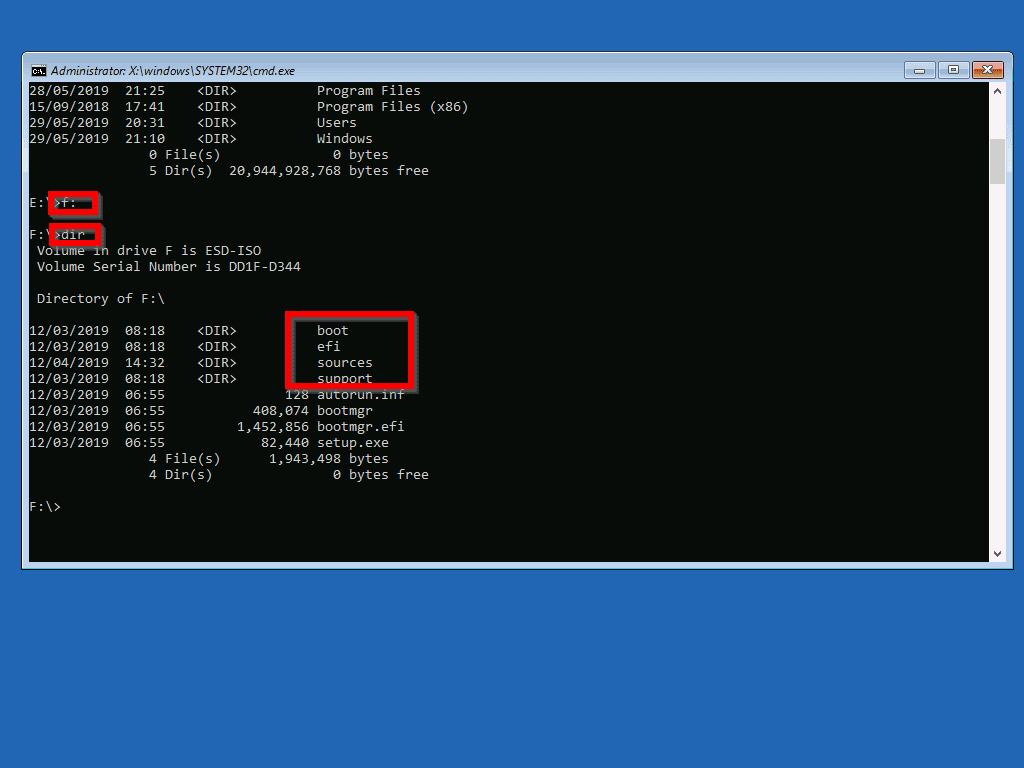- The source files could not be found. Use the 'Source' option to specify the location of the files that are required t o restore the feature. For more information on specifying a source location, see.
- After many tests I realized that the DISM could not find the source files error is happened because, in the latest Windows versions the install.esd file can contain multiple Windows 10 images (install.wim files), for several Windows versions (e.g. Windows 10 Pro, Windows 10 Home, etc.), so DISM could not find the correct files required to repair Windows.
- Dism Source Files Could Not Be Found
- Dism Source Files Could Not Be Found 0x800f081f Windows 10
- Dism Source File Could Not Be Found Error
- The Source Files Could Not Be Found Dism
Installs a Windows capability package on the specified operating system image.
When I do, it gives me a 0x800f081f; source files could not be found Part of my problem is that I'm on image version 10.0.19041.508 (Windows 10 Pro for Workstations), this particular build of course isn't available as an installation media/ISO from the Microsoft website. The DISM log file can be found at C: windows Logs DISM dism.log dism.log. PID=6660 TID=4736 The source files could not be found and download failed.
Syntax
Description
The Add-WindowsCapability cmdlet acquires a Windows capability package from a priority-ordered list of source locations, and then installs the package on the specified operating system image.
Examples
Example 1: Add a Windows capability package to the running OS via the Windows Update client
This command adds a Windows capability package to the running operating system. Because no source is specified, the Windows Update client will download the necessary package. It requires either an active Internet connection or an active network connection to the local Windows Server Update Services (WSUS) server.
Example 2: Add a Windows capability package to the running OS using a locally stored package file
This command adds a Windows capability package specified by the Name parameter, to the running operating system. The Source parameter specifies the location of required files. For instance, if the running OS is a copy of Windows 10 version 1809, the Msix-PackagingTool-Driver-Package~31bf3856ad364e35~amd64~~.cab file must be present at E:.
If the package specified by the Name parameter is already installed, this command does not return an error message, regardless of whether the required files are present at E:.
Example 3: Add a Windows capability package to an image

This command adds a Windows capability package specified by the Name parameter, to the operating system image at the path C:mountWindows. The Source parameter specifies the location of required files. For instance, if the mount point contains a copy of Windows 10 version 1809, the Msix-PackagingTool-Driver-Package~31bf3856ad364e35~amd64~~.cab file must present at E:.
Parameters
Indicates that this cmdlet does not query Windows Update for source packages when servicing a live OS. Only applies when the -Online switch is specified.
Dism Source Files Could Not Be Found
| Type: | SwitchParameter |
| Position: | Named |
| Default value: | None |
| Accept pipeline input: | True |
| Accept wildcard characters: | False |
Specifies the maximum output level shown in the logs.
| Type: | LogLevel |
| Aliases: | LL |
| Accepted values: | Errors, Warnings, WarningsInfo |
| Position: | Named |
| Default value: | WarningsInfo |
| Accept pipeline input: | True |
| Accept wildcard characters: | False |
Dism Source Files Could Not Be Found 0x800f081f Windows 10
Specifies the full path and file name to log to.If not set, the default is '$env:WINDIRLogsDismdism.log'.In Windows PE, the default directory is the RAMDISK scratch space which can be as low as 32 MB.The log file will automatically be archived.The archived log file will be saved with .bak appended to the file name and a new log file will be generated.Each time the log file is archived the .bak file will be overwritten.When using a network share that is not joined to a domain, use the net use command together with domain credentials to set access permissions before you set the log path for the DISM log.
| Type: | String |
| Aliases: | LP |
| Position: | Named |
| Default value: | None |
| Accept pipeline input: | True |
| Accept wildcard characters: | False |
Specifies the identity of the capability to add to an operating system image.
| Type: | String |
| Position: | Named |
| Default value: | None |
| Accept pipeline input: | True |
| Accept wildcard characters: | False |
Indicates that the cmdlet operates on a running operating system on the local host.
Dism Source File Could Not Be Found Error
| Type: | SwitchParameter |
| Position: | Named |
| Default value: | None |
| Accept pipeline input: | True |
| Accept wildcard characters: | False |
Specifies the full path to the root directory of the offline Windows image that you will service.If the directory named Windows is not a subdirectory of the root directory, WindowsDirectory must be specified.
| Type: | String |
| Position: | Named |
| Default value: | None |
| Accept pipeline input: | True |
| Accept wildcard characters: | False |
Specifies a temporary directory that will be used when extracting files for use during servicing.The directory must exist locally.If not specified, the '$env:Temp' directory will be used, with a subdirectory name of a randomly generated hexadecimal value for each run of DISM.Items in the scratch directory are deleted after each operation.You should not use a network share location as a scratch directory to expand a package (.cab or .msu file) for installation.The directory used for extracting files for temporary usage during servicing should be a local directory.
| Type: | String |
| Position: | Named |
| Default value: | None |
| Accept pipeline input: | True |
| Accept wildcard characters: | False |
Specifies the location of the files that are required to add a Windows capability package to an image. If you specify multiple Source arguments, the files are gathered from the first location where they are found and the rest of the locations are ignored. Separate source locations with a comma.

If you do not specify a Source, the default location set by Group Policy is used. If that fails, Windows Update is also used for online images, unless LimitAccess is specified. When all fail, the cmdlet fails silently; no exceptions are thrown.
Source can only be used when servicing images that are running at least Windows® 8 or Windows Server® 2012.
| Type: | String[] |
| Position: | Named |
| Default value: | None |
| Accept pipeline input: | True |
| Accept wildcard characters: | False |

Specifies the path to the location of the BootMgr files.This is necessary only when the BootMgr files are located on a partition other than the one that you are running the command from.Use -SystemDrive to service an installed Windows image from a Windows PE environment.
| Type: | String |
| Position: | Named |
| Default value: | None |
| Accept pipeline input: | True |
| Accept wildcard characters: | False |

Specifies the path to the Windows directory relative to the image path.This cannot be the full path to the Windows directory; it should be a relative path.If not specified, the default is the Windows directory in the root of the offline image directory.
| Type: | String |
| Position: | Named |
| Default value: | None |
| Accept pipeline input: | True |
| Accept wildcard characters: | False |
Outputs
Microsoft.Dism.Commands.ImageObject
Notes
As of Windows 10 version 1709, you cannot use Windows Server Update Services (WSUS) to host Features on Demand (FOD) and language packs for Windows 10 clients. Instead, you can enforce a Group Policy setting that tells the clients to download them directly from Windows Update. You can also host FOD and language packs on a network share, but starting with Windows 10 version 1809, FOD and language packs can only be installed from Windows Update. For more information, see How to make Features on Demand and language packs available when you're using WSUS/Configuration Manager.
The Source Files Could Not Be Found Dism
Related Links
